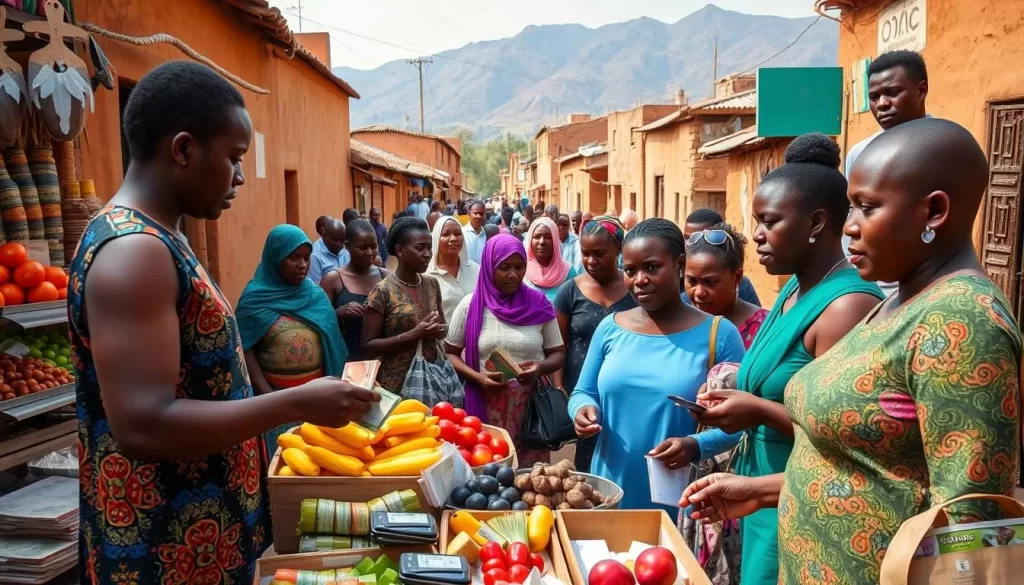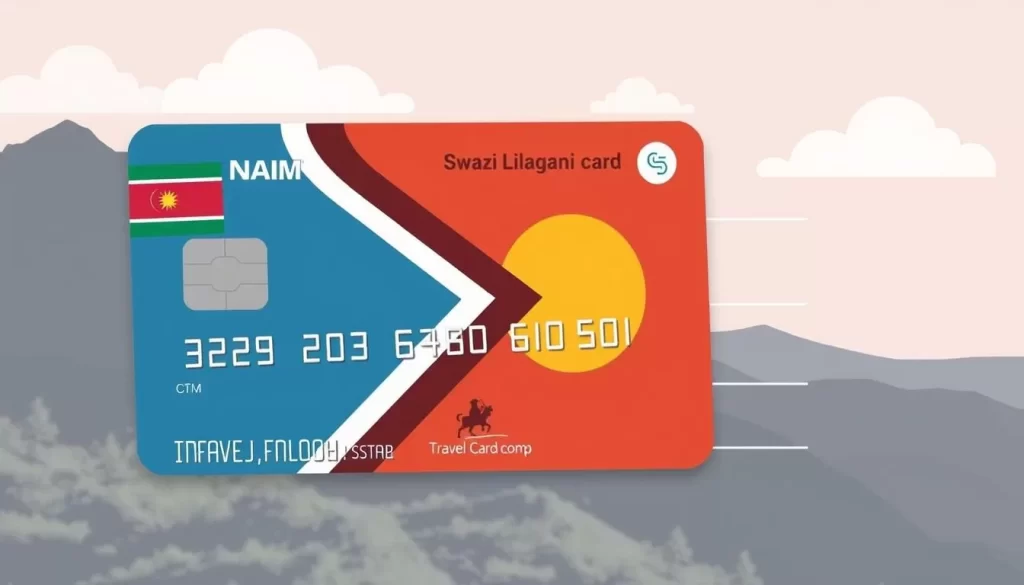Are you planning a trip to this unique African kingdom? Understanding the local currency is crucial for a smooth and cost-effective journey. Travelers often lose up to 10% of their budget due to unfavorable exchange rates.
To avoid unnecessary fees and hassles, it’s essential to plan ahead. In Swaziland, the official currency is the Swazi Lilangeni (SZL). By knowing how to manage your money effectively, you can save significantly and enjoy your trip to the fullest.
This guide will walk you through the local currency system and payment options, ensuring you’re well-prepared for your travel to this beautiful country. You’ll learn about exchange rates, ATM access, card payments, and local payment customs, helping you make the most of your travel experience.
Understanding Eswatini’s Currency System
When traveling to Eswatini, it’s essential to understand the local currency system to make the most of your trip. The country’s official currency is the Swazi Lilangeni (SZL), which is pegged to the South African Rand (ZAR) at a 1:1 exchange rate. This unique monetary policy allows for flexibility in financial transactions during your visit.
The Swazi Lilangeni (SZL): Basic Information
The Swazi Lilangeni is the official currency of Eswatini, and understanding its value is crucial for a smooth travel experience. The currency is issued by the Central Bank of Eswatini and is available in various denominations. Due to its 1:1 exchange rate with the South African Rand, both currencies are widely accepted in the country, making it relatively easy for tourists to navigate financial transactions.
Currency Denominations and Features
The Swazi Lilangeni comes in banknotes of 10, 20, 50, 100, and 200 emalangeni, while coins are available in smaller denominations, making it easy to handle everyday transactions. The banknotes feature distinct colors and designs, such as the E10 note being brown, E20 green, E50 pink, E100 blue, and E200 purple, making them easily identifiable. Each banknote displays the portrait of King Mswati III on the front, while the reverse sides showcase different aspects of Eswatini’s culture and landmarks. The banknotes also include several security features like watermarks and raised printing to help verify their authenticity. It’s advisable to carry a mix of small and large denominations, as smaller businesses may struggle with change for larger bills. Additionally, due to the currency’s parity with the South African Rand, you’ll find that South African coins and notes circulate alongside the Lilangeni, giving you more flexibility in your payment options, especially when dealing with businesses near the border or in tourist areas.
Exchange Rates and Currency Conversion
The exchange rate between your home currency and the Swazi Lilangeni (SZL) is a critical factor to consider when budgeting for your trip to Eswatini.
Exchange rates are a crucial aspect of international travel, and understanding how they work can significantly impact your trip. The exchange rate determines how much local currency you’ll receive in exchange for your money.
Current USD to SZL Exchange Rates
The current exchange rate between the US dollar (USD) and the Swazi Lilangeni (SZL) is an essential piece of information for travelers. As of the latest updates, the exchange rate is subject to fluctuations. Checking the latest rates before your trip can help you plan your expenses better.

Understanding the Mid-Market Rate
The mid-market rate, also known as the interbank rate, is the average exchange rate between two currencies. It’s considered the fairest rate, as it’s not influenced by the markups that banks and currency exchange services add. Understanding the mid-market rate can help you identify whether you’re getting a good deal when exchanging your currency.
How Exchange Rates Impact Your Travel Budget
Exchange rates have a direct impact on your travel budget. A favorable exchange rate can stretch your dollars further, while an unfavorable rate can increase your expenses. For instance, if the SZL strengthens against the USD, your budget may not go as far as you planned.
To illustrate the impact of exchange rates on travel budgets, consider the following table:
| Exchange Rate (1 USD to SZL) | 100 USD in SZL | Impact on Travel Budget |
|---|---|---|
| 15 SZL | 1,500 SZL | Favorable – More SZL for your USD |
| 12 SZL | 1,200 SZL | Less favorable – Fewer SZL for your USD |
By understanding how exchange rates work and keeping an eye on the current rates, you can make informed decisions about your currency exchanges and ensure that your trip to Eswatini stays within your budget.
Best Ways to Exchange Currency for Eswatini
Before you travel to Eswatini, it’s essential to know the best methods for exchanging your currency to get the most out of your trip. Exchanging currency effectively can significantly impact your travel budget, allowing you to enjoy more of what Eswatini has to offer.
Should You Exchange Money Before Your Trip?
Exchanging some money before your trip can be a good idea to have local currency, Swazi Lilangeni (SZL), for when you arrive. However, it’s crucial to compare rates and consider the fees associated with exchanging money before you travel. Some services offer competitive rates, but others might charge high fees or offer poor rates. It’s also worth noting that not all currencies can be easily exchanged in Eswatini, so having some local currency or a widely accepted currency like USD can be beneficial.
Tips for exchanging money before your trip: Look for reputable currency exchange services or banks that offer competitive rates and low fees. Avoid exchanging money at airports or tourist areas, as rates tend to be less favorable.
Currency Exchange Options in Eswatini
Once in Eswatini, you have several options for exchanging currency. You can exchange money at banks, currency exchange offices, or use ATMs to withdraw SZL. Banks typically offer the best exchange rates, but it’s essential to compare rates among different banks and be aware of any fees associated with the transaction. ATMs are widely available and usually offer a convenient way to obtain local currency.
Avoiding Poor Exchange Rates and Hidden Fees
To avoid losing money to poor exchange rates and hidden fees, always compare the offered rate to the mid-market rate. Be cautious of services that advertise “no commission” or “zero fees,” as they might compensate by offering worse exchange rates. When using ATMs, choose those operated by major banks and opt for fewer, larger withdrawals to minimize per-transaction fees. Consider using modern financial services like Wise or Revolut, which often offer exchanges closer to the mid-market rate and clearly disclose all fees upfront.
Key tips: Always decline Dynamic Currency Conversion (DCC) when offered, as it usually includes hidden markups. Be aware of the fees associated with your card or exchange service, and plan your exchanges accordingly to minimize costs.
Cash vs. Cards: Payment Methods in Eswatini
To navigate Eswatini’s economy effectively, it’s essential to know when to use cash versus cards. Understanding the local payment landscape can help you manage your expenses better and avoid unnecessary fees.
When to Use Cash in Eswatini
While many places in Eswatini accept cards, there are still instances where cash is preferred or required. For smaller purchases, traditional markets, and some rural areas, it’s best to have some local currency, the Swazi Lilangeni (SZL), on hand. Using cash can also help you stick to your budget, as you’ll see the money leaving your wallet.
Credit and Debit Card Acceptance
Credit and debit cards are widely accepted in tourist areas, hotels, and larger establishments. Major brands like Visa and Mastercard are commonly accepted, while American Express and Diners Club are less so. It’s a good idea to inform your bank of your travel plans to avoid any transaction issues. When using cards, make sure you’re charged in SZL to avoid Dynamic Currency Conversion (DCC) fees.

Dynamic Currency Conversion: What to Watch For
When making a purchase or withdrawing cash, you might be offered the option to be charged in your home currency instead of SZL. This is known as Dynamic Currency Conversion, and it often comes with additional fees and a less favorable exchange rate. To avoid these extra costs, always choose to be charged in the local currency, SZL. Be aware that some merchants might automatically apply DCC, so it’s crucial to check your receipt carefully before confirming the transaction.
By being mindful of your payment methods and understanding the implications of DCC, you can save money and make your trip to Eswatini more enjoyable.
Travel Money Cards for Visiting Eswatini

The right travel money card can make a significant difference in your Eswatini travel experience by offering convenience and cost savings. Travel money cards are designed to provide a secure and efficient way to manage your finances while abroad.
Benefits of Using Travel Money Cards
Travel money cards offer several benefits, including the ability to hold multiple currencies, competitive exchange rates, and low transaction fees. They are also often equipped with advanced security features, making them a safe option for travelers. By using a travel money card, you can avoid the hassle of exchanging cash and minimize the risk of carrying large amounts of money.
Top Travel Money Cards for U.S. Travelers
Several travel money cards are available that cater to the needs of U.S. travelers visiting Eswatini. Some of the top options include:
- The Wise Multi-Currency Card: Known for its flexibility and low fees, this card allows you to hold and spend in over 40 currencies, including the Swazi Lilangeni. It offers near mid-market exchange rates and minimal transaction fees, making it a cost-effective choice.
- Revolut: Provides competitive exchange rates, free ATM withdrawals up to $300 monthly, and advanced security features like virtual cards and transaction notifications.
- The Charles Schwab High Yield Investor Checking debit card: Offers unlimited ATM fee rebates worldwide, ideal for travelers who need frequent cash access in Eswatini.
- Capital One360: Provides a fee-free debit card option with no foreign transaction fees and no minimum balance requirements.
- Netspend Prepaid Card: Allows you to load funds before your trip, though it comes with higher fees compared to some other options.
- Chime: Offers debit cards with no foreign transaction fees and competitive exchange rates, along with user-friendly mobile apps for managing your money on the go.
When selecting a travel money card, consider factors beyond just fees, such as ATM access, customer service availability while traveling, and emergency card replacement options in case your card is lost or stolen in Eswatini. Choosing the right providers can significantly enhance your travel experience.
ATM Access and Withdrawal Strategies
Accessing cash in Eswatini can be straightforward if you know where to look and how to use ATMs securely. Understanding the local ATM landscape is crucial for a hassle-free trip.
Finding ATMs in Eswatini
ATMs are widely available in major towns and tourist areas in Eswatini. You can find them in bank branches, shopping malls, and some hotels. It’s a good idea to use ATMs located in secure, well-lit areas to minimize the risk of crime. When in rural areas, ATMs might be less common, so it’s advisable to withdraw cash when you’re in larger towns.
ATM Fees and How to Minimize Them
When using ATMs in Eswatini, be aware that you may be charged fees by both your home bank and the local bank operating the ATM. To minimize these fees, use ATMs affiliated with your bank’s international network. Some banks and credit card companies also offer travel-friendly accounts with reduced or no foreign transaction fees.
| Bank | ATM Fee | Foreign Transaction Fee |
|---|---|---|
| Standard Bank | $2-$5 | 1%-3% |
| Nedbank | $3-$6 | 1%-3% |
| FirstRand Bank | $2-$4 | 1%-2% |
Safety Tips for ATM Withdrawals
Crime is a significant concern in Eswatini, and using ATMs requires caution. Always use ATMs in secure locations like inside bank branches or shopping malls. Be aware of your surroundings, shield your PIN entry, and avoid counting cash in public. Consider having someone with you when making larger withdrawals, especially in areas known for higher crime rates.
By being informed and cautious, you can safely access your money in Eswatini. Remember to notify your bank of your travel plans to avoid any transaction issues.
Budgeting for Your Eswatini Trip
Your Eswatini adventure can be both memorable and affordable with the right budgeting strategies. Effective budgeting allows you to enjoy the rich cultural heritage and natural beauty of Eswatini without financial stress.
Average Daily Costs in Eswatini
Understanding your average daily costs is crucial for budgeting your trip to Eswatini. On average, a traveler can expect to spend around E500-1000 per day, depending on their travel style and accommodation choices. This amount covers meals, transportation, and activities. For instance, meals can range from E30-80 at local eateries to E150-300 at tourist-oriented restaurants.
| Expense Category | Low Budget (E) | Mid-Range (E) | Luxury (E) |
|---|---|---|---|
| Accommodation per night | 200-500 | 500-1000 | 1500-3000 |
| Meal per person | 30-80 | 80-150 | 200-500 |
| Transportation per ride | 10-20 | 20-50 | 100-300 |
Budget, Mid-Range, and Luxury Spending Options
Eswatini offers a range of options for different budgets. For budget travelers, staying in guesthouses and eating at local markets can be cost-effective. Mid-range travelers can enjoy a balance of comfort and affordability, while luxury travelers can indulge in high-end lodges and fine dining experiences. Your spending options can significantly impact your overall travel budget.
Money-Saving Tips for Travelers
To save money while traveling in Eswatini, consider the following money-saving tips: Use local markets for affordable meals and shopping. Opt for public transportation like minibuses (kombis) instead of taxis. Booking accommodations in advance can also secure better rates. Additionally, purchasing a local SIM card with a data package can save on mobile charges. Take advantage of free or low-cost activities like hiking and visiting local markets.
- Travel during Eswatini’s shoulder seasons (April-May or September-October) for lower accommodation rates.
- Eat at local restaurants and market food stalls for authentic cuisine at lower prices.
- Consider accommodations with kitchen facilities to prepare some meals.
- Negotiate prices at craft markets and with guides respectfully.

Money Management Throughout Your Trip
Effective money management is crucial for a stress-free trip to Eswatini. To ensure you make the most of your travel budget, it’s essential to have a solid plan in place for managing your finances throughout your journey.
Managing Your Money Throughout Your Trip
Managing your money effectively during your trip involves a combination of preparation and real-time tracking. You should start by setting a realistic budget for your trip, considering all aspects of your travel, including accommodation, food, transportation, and activities. Budgeting apps like Mint or YNAB can help you track your spending and stay within your means.
It’s also important to have a mix of payment methods, including cash, credit cards, and debit cards, to ensure you have flexibility in different situations.
Combining Payment Methods for Maximum Flexibility
Combining different payment methods can provide you with maximum flexibility during your trip. Using a combination of cash, credit cards, and debit cards allows you to choose the most suitable payment option for each transaction, helping you manage your costs effectively. For instance, you might use cash for small purchases or at local markets, while credit cards can be used for larger transactions or at establishments that accept them.
Tracking Expenses While Traveling
Tracking your spending in real-time is crucial for staying on top of your budget during your trip. You can use dedicated travel expense tracking apps like Trail Wallet, TravelSpend, or Splitwise to record your expenses as they occur, categorize them, and monitor your adherence to your budget. Setting up daily spending alerts or limits within your tracking system can also help you stay on track.
- Use dedicated travel expense tracking apps to record your spending in real-time.
- Set up daily spending alerts or limits to receive notifications when approaching budget thresholds.
- Take photos of receipts to maintain accurate records, especially for cash transactions.
- Conduct a daily review of your expenses to identify spending patterns and make adjustments.
Digital Payment Options in Eswatini

Understanding the digital payment options in Eswatini can help you navigate the country with ease. As a traveler, having the right information about these services can save you time and enhance your overall trip experience.
Mobile Payment Apps and Services
Eswatini is embracing digital payments, and mobile payment apps are becoming increasingly popular. While specific local mobile payment apps may not be as widespread as in other countries, international apps and services are generally accepted in major cities like Mbabane and Manzini. Many people in urban areas use these services for convenience. It’s essential to research the available mobile payment services before your trip to ensure you have access to the ones that are widely accepted.
Some international mobile payment apps may be compatible with Eswatini’s banking system, allowing for seamless transactions. You should check with your bank or financial institution to see if they offer any compatible services.
Internet Banking Access While Traveling
Internet connectivity in Eswatini is generally reliable in urban areas, making it easier for travelers to access their online banking services. Before your trip, ensure your banking apps are updated, and you’ve enabled any necessary travel notifications to prevent your account from being flagged for suspicious activity. Many banks require additional security verification when detecting logins from new international locations, so have your phone accessible to receive verification codes.
Consider setting up banking alerts to receive notifications of any transactions over a certain amount, providing real-time monitoring of your accounts while traveling. This will help you stay on top of your finances during your trip.
Safety and Security for Your Money
To have a stress-free trip to Eswatini, understanding how to safeguard your money is vital. Ensuring the security of your financial assets is a top priority when traveling abroad.
Protecting Your Cash and Cards
Be mindful of your surroundings when handling cash or using cards. Keep your valuables secure and consider using a money belt or a secure wallet. It’s also a good idea to store your information, such as passport details and emergency contact numbers, securely online or in a separate safe location.
Common Financial Scams to Avoid
Be aware of potential crime such as scams or theft targeting tourists. Avoid using ATMs in isolated areas or at night, and always check the ATM for any signs of tampering. Be cautious of strangers offering unsolicited assistance or exchange services.
What to Do If Your Wallet Is Stolen
In the emergency event that your wallet is stolen, act quickly. Report the theft to the local police immediately by calling 999 or visiting the nearest station to file a report. Contact your bank and credit card companies to report stolen cards and request replacements. If you’re a U.S. citizen, you can also reach out to the U.S. Embassy in Mbabane at +268-2417-9000 for assistance.

Local Payment Etiquette and Customs
To navigate Eswatini like a local, it’s essential to grasp the local payment etiquette. Understanding these customs will not only enhance your travel experience but also show respect for the local culture. As you explore this beautiful country, you’ll encounter various situations where knowing the appropriate payment practices can make a significant difference.
Tipping Practices in Eswatini
Tipping in Eswatini is generally expected in certain situations, particularly in the service industry. For tour guides, a tip of around 10% of the total tour cost is considered standard, showing appreciation for their guide services. In restaurants, a service charge is sometimes included, but if not, a small tip is welcomed. It’s also customary to tip hotel staff for their assistance.
When it comes to tipping, it’s a way of showing appreciation for good service. The people you interact with during your trip, from hotel staff to tour guides, often rely on tips as part of their income.
Bargaining and Negotiation Expectations
Bargaining is an integral part of the shopping experience in Eswatini, especially at local markets and from street vendors. When shopping at these markets, it’s expected that you’ll negotiate the price. Start by offering about 50-60% of the initial asking price and work your way to a mutually agreeable amount. The final price usually settles around 70-80% of the original quote.
| Bargaining Tips | Initial Offer | Final Price |
|---|---|---|
| At local markets | 50-60% | 70-80% |
| For bulk purchases | Ask for a discount | Negotiable |
Approach bargaining as a friendly conversation rather than a confrontation. Showing genuine interest in the craftsmanship and the story behind the items can help build rapport with the vendor. It’s also advisable to shop early in the day at local markets, as vendors are eager to make their first sale, considered lucky. For larger purchases, don’t hesitate to ask for a “bulk discount.” This practice is expected and can lead to better rates.
By understanding and respecting local customs, you’ll not only get a more authentic experience but also contribute positively to the local economy. This guide to local payment etiquette in Eswatini will help you navigate different places with confidence, ensuring that your trip is both enjoyable and respectful.
Banking Services for Travelers in Eswatini
As you plan your trip to Eswatini, it’s essential to familiarize yourself with the country’s banking services. Understanding the available banking options can significantly enhance your travel experience, making it smoother and more enjoyable.
Major Banks and Their Locations
Eswatini has a well-developed banking sector with several major banks offering a range of services. The key players include Nedbank, Standard Bank, and Swazi Bank, among others. These banks have multiple branches across the country, including in major towns like Mbabane and Manzini. You can find information about their locations and services on their official websites or by visiting local tourist information centers.
- Nedbank: Offers a variety of banking services, including currency exchange and ATM access.
- Standard Bank: Provides comprehensive banking services, including personal and business banking.
- Swazi Bank: A local bank with a strong presence, offering services tailored to the needs of the local population and travelers.
Banking Hours and Accessibility
Banking hours in Eswatini are generally convenient for both locals and travelers. Standard banking hours are typically Monday to Friday from 8:30 AM to 3:30 PM and Saturday from 8:30 AM to 11:00 AM. Some banks in shopping malls or commercial centers may offer extended hours, staying open until 5:00 PM on weekdays to accommodate working customers. It’s also worth noting that ATMs are generally accessible 24/7, although those located inside buildings will only be available during the facility’s operating hours.
It’s advisable to plan your banking activities according to the time of your visit, especially during major national celebrations when banking services may be affected. Always carry your passport when visiting a bank branch, as identification is required for non-account holders seeking services like currency exchange.
Entry Requirements and Financial Preparations
To ensure a hassle-free trip to Eswatini, understanding the entry requirements and having your finances in order is vital. This preparation not only helps in avoiding last-minute hassles but also ensures that you can fully enjoy your travel experience without any financial stress.
Visa Requirements and Fees
Before traveling to Eswatini, it’s essential to check if you need a visa. The requirements can vary based on your nationality, so it’s crucial to consult the official government or embassy website for the most up-to-date information. Some countries are exempt from visa requirements for a certain period, while others may need to apply in advance. Understanding the visa fees and any additional documentation required is also part of the preparation process.
For U.S. citizens, for example, a visa is required for tourism or business stays up to 60 days. The process involves submitting an application along with the required fee, which can vary. Ensuring you have the correct visa and understanding any associated fees will help prevent issues upon arrival.
Notifying Your Bank Before Travel
Notifying your bank or credit card company before you travel is a simple yet crucial step. This notification helps prevent your transactions from being flagged as suspicious when you use your cards abroad. By informing them of your travel plans, you can avoid having your cards blocked or frozen, ensuring uninterrupted access to your money.
It’s also a good opportunity to inquire about any foreign transaction fees associated with your cards and to understand the exchange rates they use for transactions.
Emergency Funds and Backup Payment Methods
Having an emergency fund is a prudent measure when traveling. Consider setting aside $200-300 in a readily accessible form, such as US dollars or South African Rand, as a backup. Storing this emergency fund separately from your primary money and cards can be a lifesaver if your wallet is lost or stolen.
Additionally, having multiple payment methods, such as a debit card and a credit card from different banks, can provide alternatives if one card is compromised. Arranging for emergency funds to be wired through services like Western Union or MoneyGram is also a good strategy. Researching the locations of your embassy or consulate and storing digital copies of your financial documents can further enhance your financial security while traveling.
| Emergency Measure | Description | Benefit |
|---|---|---|
| Emergency Fund | Setting aside $200-300 in US dollars or South African Rand | Provides immediate financial backup in case of loss or theft |
| Multiple Payment Cards | Having debit and credit cards from different banks | Ensures continued access to money if one card is compromised |
| Emergency Fund Transfer | Arranging for funds to be wired via Western Union or MoneyGram | Allows for quick access to additional funds in an emergency |
Conclusion
Planning your finances for a trip to Eswatini can be a game-changer, saving you time and money. By choosing the right travel card, you may avoid unnecessary fees and enjoy better currency exchange rates. Similarly, planning your cash withdrawal strategy ensures you have access to funds without overspending on ATM fees.
This guide has covered essential tips, from understanding exchange rates to managing daily expenses in the country. To make the most of your trip, it’s crucial to be aware of the local payment methods, including the use of cards and cash. By following the strategies outlined in this guide, you can minimize currency exchange fees and avoid common financial pitfalls.
Managing your money effectively in Eswatini requires advance planning, from understanding the Lilangeni’s relationship to the South African Rand to selecting the right mix of payment methods for your travel style. Being aware of local payment customs, including tipping practices and bargaining expectations, helps you navigate financial interactions respectfully while avoiding overpaying for goods and services.
With proper preparation and the information provided in this guide, you can focus less on money management and more on enjoying the rich cultural experiences, natural beauty, and warm hospitality that Eswatini has to offer. To stay within your budget, consider reviewing this guide before your trip and keeping key information accessible during your travels to ensure smooth financial transactions throughout your Eswatini adventure.
By being mindful of your financial planning, you can ensure a stress-free and enjoyable journey to this beautiful country. Start planning your most cost-effective trip today, and use the insights provided to make informed decisions and maximize your travel budget. With a little preparation, you’ll be ready to explore Eswatini confidently and stress-free.
The above is subject to change.
Check back often to TRAVEL.COM for the latest travel tips and deals.




